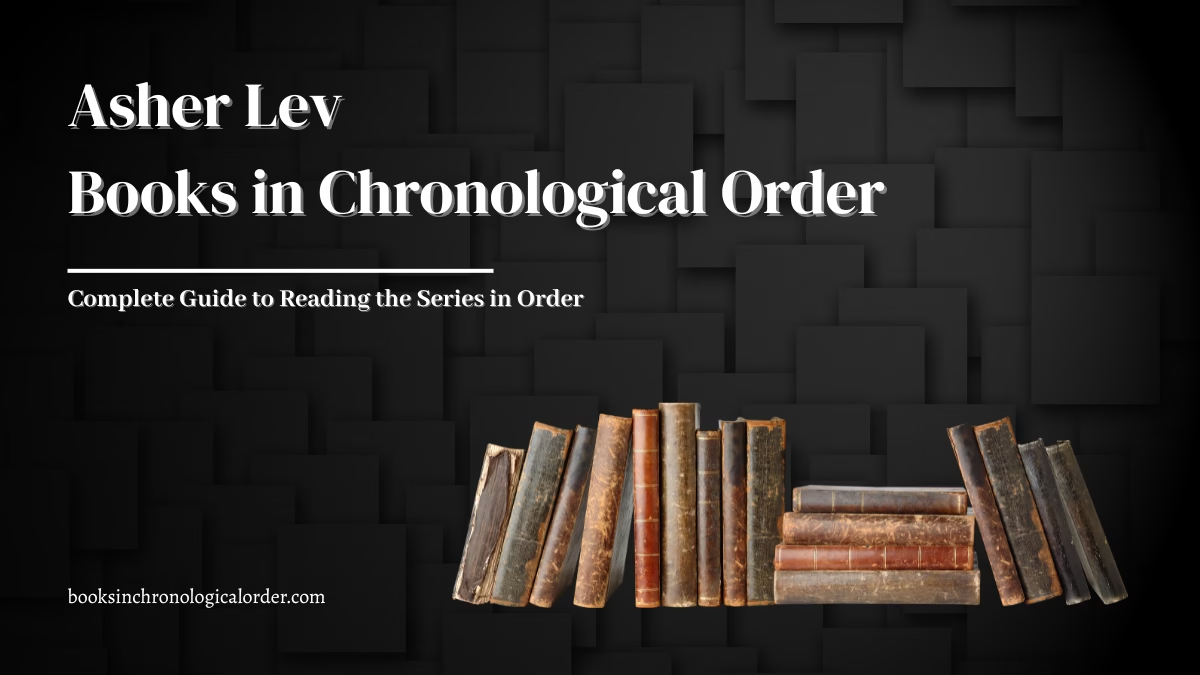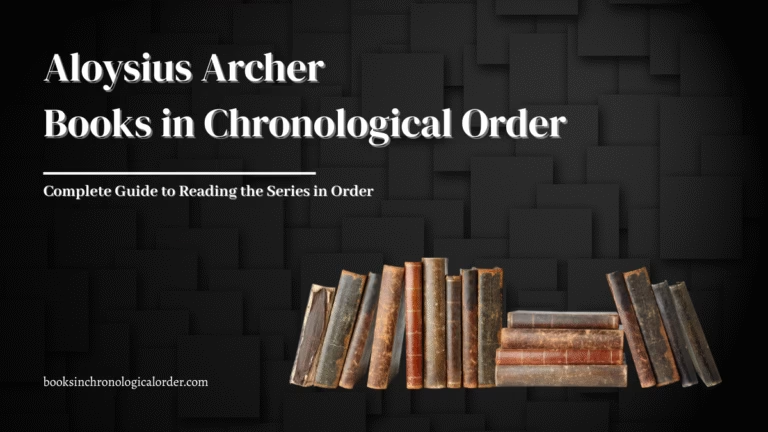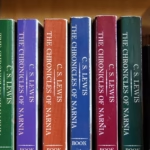Read every series in the right order

Asher Lev Books in Chronological Order – Complete Reading Guide
Table of Contents
Quick Answer (TL;DR)
Looking for Asher Lev Books in Chronological Order? Read them exactly as published:
- My Name Is Asher Lev
- The Gift of Asher Lev
No prequels, no novellas to interleave—just two exquisitely linked novels that form a complete, emotionally resonant arc.
Introduction
Some novels tell a story; others open a door you can’t close. Chaim Potok’s two-book Asher Lev cycle—beginning with the modern classic My Name Is Asher Lev and continuing decades later in The Gift of Asher Lev—does both. It tells of a boy who grows up in a cloistered Hasidic community in postwar Brooklyn, a prodigy with a gift that feels like a calling and a curse: he must paint what he sees and feels, even when the canvas scandalizes the people he loves most.
Quick Facts
| Item | Details |
|---|---|
| Series | Asher Lev (duology) |
| Primary Works | My Name Is Asher Lev; The Gift of Asher Lev |
| Author | Chaim Potok |
| Setting | Post-WWII to late-20th-century Brooklyn, later France and return trips to New York |
| Length (approx.) | My Name Is Asher Lev ~ 300–350 pp; The Gift of Asher Lev ~ 350–400 pp (editions vary) |
| Read Time | ~7–10 hours each at 35–50 pp/hour |
| Reading Difficulty | Accessible literary fiction; emotionally and philosophically rich |
| Genres | Literary fiction, Künstlerroman (artist’s coming-of-age), historical fiction, Jewish American literature |
| Core Themes | Faith vs. art, obedience vs. vocation, family loyalty, community boundaries, the cost of honesty |
| Content Guidance | Family conflict, religious tension, grief/illness, social ostracism; no graphic violence |
| Ideal Age Range | 14+ for advanced readers; 16+/adult ideal for full thematic context |
| Media Adaptations | Award-winning stage play adaptation of My Name Is Asher Lev (Off-Broadway and regional productions) |
About the Asher Lev Book Series
The Asher Lev novels are intimate portraits of an extraordinary talent under ordinary pressures—parents, school, neighbors, a beloved Rebbe, the pull of tradition, the dictates of an artist’s eye. The first book traces Asher from early childhood into young adulthood as his gift collides with his Hasidic world. The second revisits Asher two decades later: now a celebrated painter living in France, a husband and father called back to Brooklyn by a family death—and by the unsolved questions that have always stalked his art.
Why do these books endure in courses and book clubs? Because they frame classic conflicts—duty and desire, heritage and innovation, piety and truth-telling—without resorting to caricature. Potok writes the community with love and clarity, the artist with sympathy and steel, and the family with the ache and tenderness of people doing their flawed best.
Asher Lev Books at a Glance
| # | Title | Amazon Buy Link |
|---|---|---|
| 1 | My Name Is Asher Lev | Buy On Amazon |
| 2 | The Gift of Asher Lev | Buy On Amazon |
Asher Lev Books in Chronological Order
1) My Name Is Asher Lev
The setup: A boy is born with a hand that won’t stop drawing. He is a Ladover Hasid, raised to keep kosher, to pray, to honor his parents, and to trust a community whose Rebbe carries real, lived authority. But the same hand that draws also wounds: Asher’s gift is to see what is actually there, including the pain his parents carry and the sorrow that history has burned into their faces. The more honest his art, the louder the conflict.
You’ll experience (no spoilers):
- An artist’s apprenticeship: mentors who stretch Asher’s technique and ask whether beauty can shoulder truth.
- Family tension with love at its core: not sentimental, not vindictive—just the hard truth that people can be deeply good and still be hurt by the things you must do.
- Art and theology in conversation: Can certain images be holy or unholy? What does it mean to “profane” when the aim is truth?
Why it matters: The novel carves one of literature’s definitive portraits of the artist as a child who becomes a man without losing sight. It’s heartbreaking and luminous—a book about the price of seeing and the cost of being seen.
2) The Gift of Asher Lev
The setup: Twenty years later. Asher is famous, living in France with his wife and children, but success hasn’t quieted the questions. A beloved uncle dies. Asher returns to Brooklyn, where the air is thick with memory and expectation. Old arguments resume with new stakes. There’s a community that once felt wounded by his paintings, and there is a family whose future turns on choices that only he can make.
You’ll experience (no spoilers):
- Artistic direction and renewal: what an artist paints next when the world already has a version of you.
- Fatherhood and legacy: the fierce wish to shield children from your storms—and the knowledge that they inherit some of them anyway.
- A different Rebbe’s world: institutional continuity and change; leadership as caretaking of souls and stories.
Why it matters: If the first book is about becoming an artist, the second is about the responsibilities of one—to family, to community, to the truth your hands insist upon.
Series Timeline & Character Development
Asher Lev
- Childhood → Adolescence (My Name Is Asher Lev): discovers that drawing is not a hobby but a compulsion. Learns technique; wrestles with the ethics of subject matter; confronts the limits of community approval.
- Adulthood (The Gift of Asher Lev): global success with private unease. Art, marriage, and fatherhood refocus the question: What must I paint now—and who will be hurt (or healed) when I do?
Rivkeh Lev (mother)
- A center of gentleness and grief. Her own losses (and aspirations) echo in Asher’s canvases. She is often the soul of the cost—what the artist owes the mother and what the mother owes the child who will not stop seeing.
Aryeh Lev (father)
- Duty-bound emissary of the Rebbe, traveling for communal needs. Loves his son and fears the harm art can do. His argument with Asher is the book’s beating heart: not whether the boy is gifted, but whether gift can be reconciled with covenant.
The Rebbe / mentors
- Spiritual authority with pastoral complexity. The Rebbe’s decisions shape the family’s life. Artistic mentors, meanwhile, insist that craft must match conscience, pushing Asher toward mastery that will not let him hide.
Time & Place
- Postwar Brooklyn shifts from survival and rebuilding to institutional maturity. The later timeline adds France’s art world and a return to New York, deepening the dialogue between Old World memory and New World modernity.
Novels Sorted by In-Universe Events
- My Name Is Asher Lev — birth through young adulthood (post-WWII Brooklyn).
- The Gift of Asher Lev — roughly two decades later (France and Brooklyn), with Asher established and facing new cross-pressures.
The in-world sequence matches publication order, making your Asher Lev Books in Chronological Order decision simple and optimal.
Novels Sorted by Publication
- My Name Is Asher Lev
- The Gift of Asher Lev
(Again: publication order = chronological order.)
Companion Works
These are not part of the Asher Lev duology, but readers and educators often teach or recommend them alongside:
- The Chosen and The Promise (Reuven Malter duology): friendship across Jewish worlds; tradition vs. modern scholarship. (Great thematic dialogue with Asher’s conflicts.)
- In the Beginning: a portrait of a young scholar’s awakening to biblical criticism within an Orthodox milieu.
- Davita’s Harp: a girl’s encounter with ideology, faith, and family through the arts and politics of the 1930s.
Why pairings help: Potok’s larger project is the “core-to-core encounter” between a traditional religious culture and modern secular disciplines (art, psychology, historical criticism). Reading beyond Asher spotlights how these tensions play out in different lives.
Editions & Formats (hardcover, collector, audio)
Paperback / Trade
- Most accessible price point. Many printings include reader’s guides and discussion questions—excellent for classrooms and clubs.
Hardcover / Library Bindings
- Durable for repeated study. Collectors may prefer early hardbacks or matched modern reissues. Dust-jacket art varies widely; check ISBNs if you want a coordinated look.
Kindle / eBook
- Searchable quotes and notes (great for annotating passages on aesthetics, halakha, and family scenes). Syncs across devices for classroom prep.
Audiobook
- Potok’s prose is dialogue-rich and reflective—ideal for audio. A strong narration highlights the textures of family conversation, yeshiva study, and studio moments.
Collector Tip
- If you love consistent spines, source a matched two-volume set in trade paperback from the same publisher line or search for coordinated cover art modern reissues. Used markets often carry first editions for serious collectors.
Why Read Asher Lev Books in Chronological Order?
- Authorial architecture: The second book assumes the spiritual, familial, and artistic history built in the first. Reading out of order blunts the emotional voltage of several crucial reversals.
- Character continuity: Asher’s relationships—especially with his parents and the Rebbe’s court—only make full sense if you’ve watched the first book’s conflicts mature.
- Thematic deepening: The Gift of Asher Lev isn’t a victory lap. It’s a new, harder question: what does truth-telling look like for a man with dependents, memories, and a reputation? You need the first book to feel the second’s stakes.
In short, Asher Lev Books in Chronological Order is also the most powerful literary experience, the one Potok built.
Author Spotlight: Chaim Potok
Chaim Potok (1929–2002) was an American novelist and rabbi whose work opened doors for millions of readers into the intimate, often misunderstood worlds of Orthodox and Hasidic Judaism—without ever flattening them into types. His debut, The Chosen, spent 39 weeks on the New York Times bestseller list and set a high bar: fiction that respects faith and shows its complexities, written in lucid prose with moral seriousness and warmth.
Potok’s hallmarks
- Moral clarity with compassion: He writes arguments as conversations among people who love one another, not as winners and losers.
- The artist/scholar as protagonist: Whether painter, student, or psychologist, his heroes must decide what integrity costs—and pay it.
- The stage of the home: Family rooms, kitchens, and study houses become theaters where the grand themes (history, theology, aesthetics) play out in lived detail.
The Asher Lev books represent Potok at his fiercest and most tender: unblinking about the pain art can cause, unwilling to let love or faith become clichés.
Media Adaptations (film, TV, stage)
- Stage: My Name Is Asher Lev has enjoyed an acclaimed life in the theater (regional premieres, an Off-Broadway run, and awards including the Outer Critics Circle Award for Outstanding New Off-Broadway Play and the John Gassner Award). The play condenses settings while preserving the novel’s ethical and emotional arguments—an excellent classroom or book-club companion.
- Screen: No widely released feature film of the Asher books to date. (If you’re hunting for on-screen Potok, the better-known adaptation is The Chosen—different series, same author.)
Teaching tip: Pair a few key scenes from the play script with corresponding novel chapters to discuss what stagecraft reveals: how silence, distance, and sightlines perform the book’s central question—“What must I paint, and who will be hurt if I do?”
FAQs
What’s the correct order again?
My Name Is Asher Lev → The Gift of Asher Lev. That is the Asher Lev Books in Chronological Order and the publication order.
Can I read the second book first?
You can—but you’ll lose crucial background and dull the sequel’s emotional and ethical stakes. Read in order
Is this appropriate for teens?
Yes, especially high schoolers. There’s no graphic content, but the emotional intensity and theological/aesthetic debates benefit from guided discussion.
Is Potok “taking sides” against the community?
No. Potok’s sympathetic to both tradition and the artist’s truthful vision. He dramatizes conflict rather than preaching conclusions. Many readers from observant backgrounds appreciate the nuance.
What themes make for great book-club conversations?
– The difference between honoring and obeying parents
– The ethics of representation (are there things an artist “should not” paint?)
– What makes a work “blasphemous” vs. “prophetic”
– How grief shapes vocation
– Community belonging vs. individual calling
Classroom tie-ins?
History (postwar American Judaism), Visual Arts (studio practice and criticism), Religious Studies (halakha, leadership, authority), Ethics (duty to truth vs. duty to family).
Final Thoughts
Start where the heartbeat is loudest: a boy who must draw. Then follow him across decades as the canvases get larger and the prices—social, familial, spiritual—rise. Read the Asher Lev Books in Chronological Order and you’ll feel what so many readers, students, and theater audiences have felt: that art and love are not enemies, but they are not easy friends either. Potok refuses to let us look away from that difficulty. In return, he gives us two novels that are honest, humane, and endlessly discussable—books that make you want to talk about what you owe your people and what you owe your gift.






